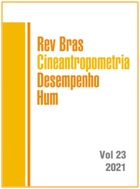Small-Sided Games as Holons in the Football: a hierarchical systems approach
DOI:
https://doi.org/10.1590/1980-0037.2021v23e74081Resumen
Sports science has showed benefits in the use of small-sided games in the teaching-learning and training processes of football. We propose that such benefits occur because the small-sided games are holons of a hierarchically organized that maintain the same characteristics of game, regardless the reduced complexity. The hierarchical model of football considers the numerical relations of cooperation and opposition in specific spaces of play. It characterizes a nested hierarchy model because it deals with both the parts and the different processes of game. Such a hierarchical model contains five levels, in which the upper level is the football game and the elementary level a game situation, that is, a small-sided game. As any open system of hierarchical organization, the small-sided games present simultaneously invariant characteristics of whole and the specificities of the parts according the context and level of analysis. The adoption of such a hierarchical perspective allows setting goals as well as selecting the teaching-learning and training’s contents at different analysis levels by considering the autonomy-dependency in each one.
Citas
Machado J, Barreira D, Teoldo I, Travassos B, Bosco Júnior J, Santos J, Scaglia A. How Does the Adjustment of Training Task Difficulty Level Influence Tactical Behavior in Soccer? Res Q Exerc Sport 2019; 90 (3): 403–416.
Davids K, Araújo D, Correia V, Vilar L. How Small-Sided and Conditioned Games Enhance Acquisition of Movement and Decision-Making Skills. Exerc Sport Sci Rev 2013; 41 (3): 154–161.
Corrêa U, Alegre F, Freudenheim A, Santos S, Tani G. The game of futsal as an adaptive process. Nonlinear Dynamics Psychol Life Sci 2012; 16 (2): 185–204.
Araújo D, Davids K. Team Synergies in Sport: Theory and Measures. Front Psychol 2016; 7: 1449.
McGarry T, Anderson D, Wallace S, Hughes M, Franks I. Sport competition as a dynamical self-organizing system. J Sports Sci 2002; 20 (10): 771–781.
Prigogine I. Time, structure, and fluctuations. Science 1978; 201 (4358): 777–785.
von Bertalanffy L. The theory of open systems in physics and biology. Science 1950; 111 (2872): 23–29.
Bizarri M, Giuliani A, Pensotti A, Ratti E, Bertolaso M. Co-emergence and Collapse: The Mesoscopic Approach for Conceptualizing and Investigating the Functional Integration of Organisms. Front Physiol 2019; 10: 924.
Wu J. Hierarchy Theory: an overview. In: Rozzi R, Pickett S, Palmer C, Armesto J, Callicott J, organizers. Linking Ecology and Ethics for a Changing World: Values, Philosophy, and Action. New York: Springer; 2013. p. 281–301.
Koestler A. The ghost in the machine. New York: Random House; 1967.
Costa I, Garganta J, Greco P, Mesquita I, Maia J. Sistema de avaliação táctica no Futebol (FUT-SAT): Desenvolvimento e validação preliminar. Motri 2011; 7 (1): 69–83.
Moura F, van Emmerik R, Santana J, Martins L, Barros R, Cunha S. Coordination analysis of players’ distribution in football using cross-correlation and vector coding techniques. J Sports Sci 2016; 34 (24): 2224–2232.
Low B, Coutinho D, Gonçalves B, Rein R, Memmert D, Sampaio J. A Systematic Review of Collective Tactical Behaviours in Football Using Positional Data. Sports Med 2020; 50: 343–385
Laakso T, Davids K, Liukkonen J, Travassos B. Interpersonal Dynamics in 2-vs-1 Contexts of Football: The Effects of Field Location and Player Roles. Front Psychol 2019; 10: 1407.
Corrêa U, Pinho S, Silva Filho A. Aprendizagem motora e o ensino do futsal. In: Tani G, Corrêa U, organizers. Aprendizagem motora e o ensino do esporte. São Paulo: Blucher; 2016. p. 163–177.
Descargas
Publicado
Número
Sección
Licencia

Direitos Autorais para artigos publicados nesta revista são do autor, com direitos de primeira publicação para a revista. Em virtude da aparecerem nesta revista de acesso público, os artigos são de uso gratuito, com atribuições próprias, em aplicações educacionais e não-comerciais, desde que seja dada a atribuição. Esta obra foi licenciada com uma Licença Creative Commons Atribuição 4.0 Internacional - CC BY


